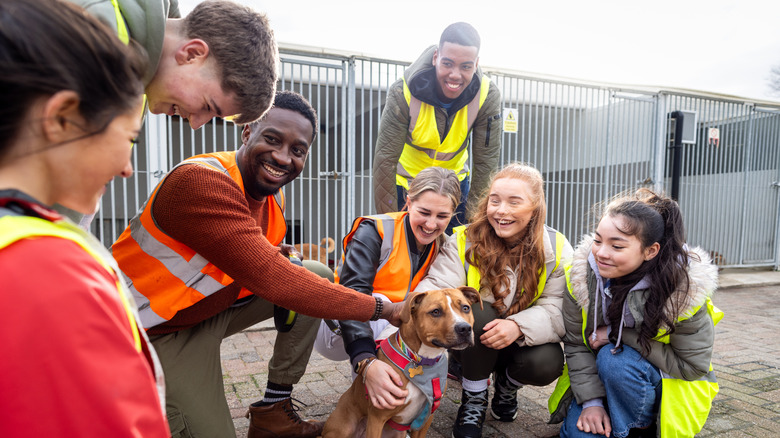Ways To Help Pet Shelters Without Adopting Or Giving Money
Every year, millions of pets end up in shelters, which are often short-staffed. Perhaps you've seen a social media ad posted by your local animal shelter with an urgent request for help from the community. Some facilities waive adoption fees or hold adoption events at pet stores with hopes of helping more dogs and cats find loving homes. It's natural for any pet-lover to want to support this mission, but that doesn't necessarily mean you have to adopt or even donate. There are many ways you can help pet shelters empty their cages and kennels, including volunteering and fostering.
You might not be in a position to make a permanent commitment to a new pet, or maybe you can't afford to make a major monetary donation right now. The good news is that you don't have to. You can still make a difference in the lives of multiple animals while helping the shelter employees at the same time. What's nice about the following options is that many offer flexibility to accommodate both working and non-working adults and teens.
Volunteer at the animal shelter
Many shelters offer volunteer opportunities, giving pet lovers the chance to be around animals while helping to improve their physical and mental health. Unfortunately, many animals don't get the amount of daily exercise they should while living in shelters. Plus, kennel stress commonly affects both dogs and cats in these environments, causing a range of behavioral problems. For example, some dogs bark constantly or become restless, while cats over-groom themselves or show signs of aggression.
Imagine having to spend 20+ hours in the same small space where there's constant noise and sounds of chaos around you. Sounds miserable, right? Well, it's no fun for animals, either, but some shelters are so overcrowded and understaffed that there simply aren't enough hours in a day for every pet to receive the daily physical or mental enrichment they need. By signing up to be a volunteer, however, you can help meet these needs for multiple animals.
Typically, shelters require that prospective volunteers fill out an application, participate in training, and commit to a certain number of hours per week or month. As a volunteer, you can play with the animals, help keep their living spaces clean, walk them, or help with adoption events, fundraising, and community outreach. Ask your local shelter about its volunteer policy to learn more about how you can assist.
Take a dog out for a day getaway
Adopted dogs aren't the only ones that can enjoy excursions. Shelter dogs can, too! This is another volunteer option that many people don't realize exists at many shelters. Assuming yours offers it, here's the gist of it: Tell the front-desk person that you'd like to take a dog out for a getaway. Then, you'll be able to choose the one you're interested in and meet it in a private area. This time gives you the opportunity to assess the dog's behavior and cooperation level; some dogs take longer to warm up to strangers than others.
When you find a good fit, you'll sign some paperwork before the dog is released to you. Depending on the shelter's policy, you might get to take your new friend for a quick stroll around the block or a visit to a nearby park if you're short on time. Have more time to spare? Get to the shelter early, and spend the day at the beach or take a scenic hike with the dog (with proper safety and gear, of course). You could also just hang out in your backyard, where the pup can enjoy hours of fetch and belly rubs.
Feel free to ask the staff if they have recommendations for a doggy day out. Don't forget to bring poop bags, a bowl, and plenty of water if you'll be outdoors all day, especially if it's a scorcher. Keep in mind that the shelter will likely require that you return the dog by a specific time, so plan your day accordingly.
Host a pawjama party for a dog
If you're considering fostering a dog for a month or longer but want to test the waters first before making the commitment, hosting a "pawjama party" gives you that opportunity. This option allows you to keep a shelter dog overnight in your home for just one night or a weekend. Contact your shelter to see if it offers this long-term foster alternative and for any restrictions or requirements it might have in place. Just as with the doggy day out, you'll be able to interact with the dog of your choice before taking it home.
Hosting a shelter dog for a sleepover gives the pup a break from the noisy shelter and a chance to relax in a cozy, calm home, complete with a soft bed and maybe even a snuggle buddy (you). Got a fenced-in yard? Toss a few of the best fetch toys for dogs around and see if you can activate the dog zoomies so it can release some of its pent-up energy. It's the ultimate doggy staycation: fun, relaxation, and a much-needed change of scenery.
If your time with the pup went well, you can extend the dog's stay at your place or just share positive details of the experience with the shelter. That way, the staff can update the dog's description, which may increase the odds of a successful adoption later. Did you teach Rocko a new trick? Did you learn that Lucy is great around children? Let the front-desk person know.
Spread the word about pets available for adoption
Whether you take advantage of one or none of the aforementioned opportunities, you can still help a pet shelter, even if you never visit it. All you need is access to social media. Many animal shelters have social media accounts that they use to spread the word about pets available for adoption and other updates, and you can help get the word out, too, using the same platforms.
In addition to sharing your local shelter's posts on your own social media page, you can share them in a community group on Facebook or Nextdoor. You can also create your own post if you want to add some more flair to the advertisement. Set your audience to "public" to reach a wider audience, and include a link to the shelter, the address, or both so viewers will know where to go.
If you ever decide to foster a dog short-term, take one out for a day getaway, or volunteer at the shelter, don't forget to film and snap photos — and lots of them! Include these in your posts, as well as details about the dog's behavior. If a certain dog at the shelter has a unique story, consider notifying a news station about it to see if it'll share it on social media or television. This approach could get the attention of someone in another state who would be willing to travel to the shelter to adopt.
Foster a dog or cat
Another way you can help a pet shelter without committing to a permanent adoption or giving money is by fostering. Many shelters are flexible with this option and don't require a minimum number of days from interested fosterers. This means you could foster for as little as a few days, a few months, or for as long as it takes for the pet to get adopted.
Fostering provides a range of benefits for the animal, the shelter, and you. Similar to the getaway and pawjama party options, it allows you to learn more about the pet's behavior, likes, and dislikes away from the shelter. You can then share this information with the shelter. It also gives you the experience with a dog of a certain size or breed that you've been considering adopting. You might discover that a husky is too much to handle or that a Chihuahua barks too much for your preferences.
Another possibility that could come from fostering is becoming "foster fail." This usually means that a foster parent fell in love with the pet they were fostering and decided to adopt it. Despite this scenario being considered a failure, it's one worthy of celebration because it ended with a pet in a happy, loving home, which is the ultimate goal of fostering anyway.





